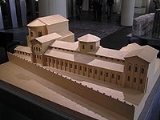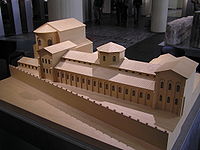
Praetorium
Encyclopedia

Etemology
The praetorium, also spelled prœtorium or pretorium, was originally used to identify the general’s tent within a Roman CastraCastra
The Latin word castra, with its singular castrum, was used by the ancient Romans to mean buildings or plots of land reserved to or constructed for use as a military defensive position. The word appears in both Oscan and Umbrian as well as in Latin. It may have descended from Indo-European to Italic...
, Castellum
Castellum
A castellum is a small Roman detached fort or fortlet used as a watch tower or signal station. The Latin word castellum is a diminutive of castra , which in turn is the plural of castrum ; it is the source of the English word "castle".The term castellum was also used to refer to a settling or...
, or encampment. The word originates from the name of the chief Roman magistrate, known as Praetor
Praetor
Praetor was a title granted by the government of Ancient Rome to men acting in one of two official capacities: the commander of an army, usually in the field, or the named commander before mustering the army; and an elected magistratus assigned varied duties...
. The general’s war council would meet within this tent, thus acquiring an administrative and juridical meaning that was carried over into the Byzantine Empire
Byzantine Empire
The Byzantine Empire was the Eastern Roman Empire during the periods of Late Antiquity and the Middle Ages, centred on the capital of Constantinople. Known simply as the Roman Empire or Romania to its inhabitants and neighbours, the Empire was the direct continuation of the Ancient Roman State...
, where the praitōrion was the residence of a city's governor. The term was also used for the emperor
Roman Emperor
The Roman emperor was the ruler of the Roman State during the imperial period . The Romans had no single term for the office although at any given time, a given title was associated with the emperor...
's headquarters. Praetorium can be used to describe the governor of a Roman province
Roman province
In Ancient Rome, a province was the basic, and, until the Tetrarchy , largest territorial and administrative unit of the empire's territorial possessions outside of Italy...
or any other large residential building or palace. The name would also be used to identify the Praetorian
Praetorian
Praetorian is an adjective derived from the ancient Roman office of praetor. It may refer to:*Praetorian Guard, a special force of skilled and celebrated troops serving as the personal guard of Roman Emperors...
Camp and Praetorian
Praetorian
Praetorian is an adjective derived from the ancient Roman office of praetor. It may refer to:*Praetorian Guard, a special force of skilled and celebrated troops serving as the personal guard of Roman Emperors...
troops stationed in Rome
Rome
Rome is the capital of Italy and the country's largest and most populated city and comune, with over 2.7 million residents in . The city is located in the central-western portion of the Italian Peninsula, on the Tiber River within the Lazio region of Italy.Rome's history spans two and a half...
. Praetor
Praetor
Praetor was a title granted by the government of Ancient Rome to men acting in one of two official capacities: the commander of an army, usually in the field, or the named commander before mustering the army; and an elected magistratus assigned varied duties...
("leader") was originally the title of the highest-ranking civil servant in the Roman Republic
Roman Republic
The Roman Republic was the period of the ancient Roman civilization where the government operated as a republic. It began with the overthrow of the Roman monarchy, traditionally dated around 508 BC, and its replacement by a government headed by two consuls, elected annually by the citizens and...
but later became a position directly below the rank of consul
Consul
Consul was the highest elected office of the Roman Republic and an appointive office under the Empire. The title was also used in other city states and also revived in modern states, notably in the First French Republic...
. A general's lifeguard was known as the cohors praetoriae, out of which developed the Pretorian Guard, the emperor's lifeguard.
Physical Description
Due to the vast number of uses for the word praetorium, describing exactly what one is can be difficult. A praetorium could be a large building, a permanent tent structure, or in some cases even be mobile.Exterior
Since the praetorium originated as the officer's quarters it could be a tent, but was often a large structure.The important design aspect of the praetorium is not symmetry, but rather proportion of one element to another. The Praetorium was constructed around two open courts, which correspond to the atrium and peristyle of the roman house. Most praetoriums had areas surrounding them delegated for exercise and drills conducted by the troops. The area ahead of the camp would be occupied by the tents housing the commander's soldiers.. They were made with brick, covered in plaster, with many Arches
Arch
An arch is a structure that spans a space and supports a load. Arches appeared as early as the 2nd millennium BC in Mesopotamian brick architecture and their systematic use started with the Ancient Romans who were the first to apply the technique to a wide range of structures.-Technical aspects:The...
and Columns
Column
A column or pillar in architecture and structural engineering is a vertical structural element that transmits, through compression, the weight of the structure above to other structural elements below. For the purpose of wind or earthquake engineering, columns may be designed to resist lateral forces...
.
Interior
Within the praetorium Roman officers would be able to conduct official business within special designed and designated areas. A Praetorium would normally display information regarding the sportulae (Schedule of fees and taxes) of its region carved directly into the walls of its main public areas. This would often be located near the office of the financial procurator.Biblical reference
In the New TestamentNew Testament
The New Testament is the second major division of the Christian biblical canon, the first such division being the much longer Old Testament....
, praetorium refers to the palace of Pontius Pilate
Pontius Pilate
Pontius Pilatus , known in the English-speaking world as Pontius Pilate , was the fifth Prefect of the Roman province of Judaea, from AD 26–36. He is best known as the judge at Jesus' trial and the man who authorized the crucifixion of Jesus...
, the Roman procurator of Judea
Judaea (Roman province)
Judaea or Iudaea are terms used by historians to refer to the Roman province that extended over parts of the former regions of the Hasmonean and Herodian kingdoms of Israel...
. According to the New Testament, this is where Jesus Christ was tried and condemned to death. The Bible refers to the Praetorium as the "common hall," the "governor's house," the "judgment hall," "Pilate's house," and the "palace." As well, Paul was held in Herod's
Herod Antipas
Herod Antipater , known by the nickname Antipas, was a 1st-century AD ruler of Galilee and Perea, who bore the title of tetrarch...
Praetorium.

